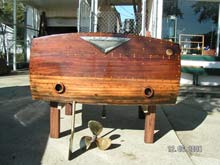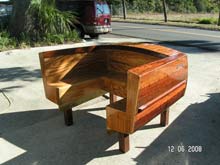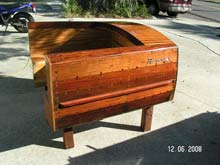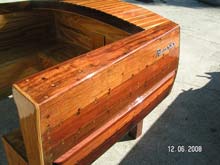 |
One of the members of the Homebrew Club I belong to had sawn off the back end of an old Century Runabout and wanted to make a bar out of it. |
One of the members of the Homebrew Club I belong to told a guy that I built boats and worked on wooden ones. The guy called me to talk about a project he wanted to do. He said he had sawn off the back end of an old Century Runabout and wanted to make a bar out of it. He was trying to get someone to look at it and tell him if it was worth messing with. The boat had been in pretty bad shape before he had taken the saw to it and that had been a couple years earlier. I kept putting him off but eventually agreed to drive out to Gulf Breeze where he lived.
When I arrived the front half of the boat was sitting on a trailer in front of his house and was sagging and drooping from exposure to the elements. The removal of the back 4 feet hadn’t done anything good for its structural integrity either. The Mother in Law met me at the door and welcomed my like a long lost son. I quickly realized that she saw me as the best opportunity to get the front half of the boat out of the driveway! In the mean time I had been covertly appraising the front half for any possible salvageable parts while talking to the Mother in Law.
What I saw was pretty bad. Although there was some wood that wasn’t completely rotted, it was all screwed to the hull and had a million holes in it. Some of the holes still had the bungs but most had long since fallen away. The structural members of the boat were nearly all rotted from years of leaves and water sitting in the bottom of the boat. After looking and looking I finally decided there was nothing in the whole front half of the boat other than bronze screws that could be salvaged and I wasn’t willing to go to the trouble to salvage them. Rodney soon came out and opened the garage where the rest of the boat was. When Rodney asked what I thought about salvaging anything from the front half. I told him to haul the entire thing to the dump and be done with it.
| When Rodney asked what I thought about salvaging anything from the front half. I told him to haul the entire thing to the dump and be done with it. |
 |
Then we turned our attention to the back portion of the boat. It had been sawn off the front half with a demolition saw and had a couple fence planks screwed to it to keep the sides from falling away from each other. The top of the stern had some sort of routed 5 inch strips that were designed to look like thinner strips that had been individually installed. Much of it was rotted and some was actually missing. The spray rails were rotten and the wood behind them had rotted places too. The lower portion of the hull was painted but had soft spots and a layer of delaminating fiberglass cloth that was put on with polyester resin. It looked pretty sad. Then I looked at the interior and was realized that the outside looked pretty good in comparison to the inside.
I had spoken to Rodney several times & had formed a reasonably educated guess as to his abilities, knowledge and aptitude for doing the kind of work it would to finish the project. So when he asked if I thought it could be done I looked him in the eye and said “Rodney, it can be done, but YOU can’t do it”! We chatted about it for a while and he was asking how much it would cost to have it done. I explained that it wasn’t like taking it to the local cabinet shop and asking them to cut some replacement panels and install them. It was more like commissioning an artist to do a piece and leaving him a “LOT” of artistic freedom! I went on to say that he’d probably have a hard time finding someone to do it without spending a lot of money because it would take a lot of time.
Rodney began asking me if I would do it and I explained that I didn’t like to work on projects but would rather build something and then sell it. That way I wouldn’t be pressured to do a better job that I might otherwise do. I also told him I didn’t have the time. He continued to press me to do it. Then I made my big mistake. I told him that it was the kind of challenge that I liked and that it did interest me. But, I explained, if I took on the project, that he couldn’t need it before Christmas….. of NEXT year! He didn’t flinch and said it had sat in his garage for two years so he figured he could wait a little longer. I realized that I had backed myself into a corner and told him I would $500 him to death until he wanted me to stop working on the project. Again he didn’t flinch. Damn it Pat, you’ve done it again. You’re stuck doing a project and this one will never even float much less go to sea!
 |
Rodney began asking me if I would do it and I explained that I didn’t like to work on projects but would rather build something and then sell it. I also told him I didn’t have the time. |
Of course he immediately brought it to my shop and dropped it off. I sat in on a dolly and began grinding, sanding and drilling. I quickly realized the boat had been sanded and refinished so many times the bungs covering the screws were paper thin and would never be able to be replaced. In addition, the screws themselves were falling out of their holes in many cases. Eventually I figured that it would be easier to drill out every screw hole and epoxy dowel pegs in place of the screws. I purposely used contrasting dowels to enhance the character of the bar. 400-plus pegs later the screws had been replaced. At that point I decided I better work on the bottom and get the thing structurally stable before spending any more time on cosmetics.
| Then I made my big mistake. I told him that it was the kind of challenge that I liked and that it did interest me. |
 |
I completely gutted the insides and removed the prop, shaft & rudder. I then gave the bar a complete bottom job with new fiberglass cloth and epoxied the frames to the planks that formed the sides. I formed plywood pieces that would serve both as the bar’s shelves as well as to provide the structural support needed to hold its shape. I fabricated some spray rails and epoxied them in place after patching the rotten wood behind them. At that point I stripped the rotted stuff off the bar-top and installed new strips of Brazilian Cherry with Oak to form the teak & holly-like bar top. It all seemed to match up pretty well with the original wood tones and color. I had pulled out the copper tailpipes and replaced them with wooden rings to give the impression of tailpipes without the knee gouging properties of the sharp metal ones. I cut off the Prop shaft & drilled a hole for a cotter pin that would keep it from slipping out of the skeg. A little polishing on the bronze prop & rudder had them looking shiny. I installed some 4X4 legs and the bar was done 3 weeks before Christmas of NEXT year!
***** |

